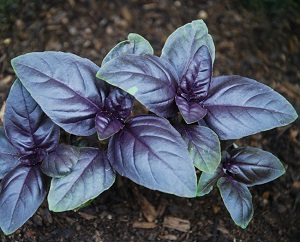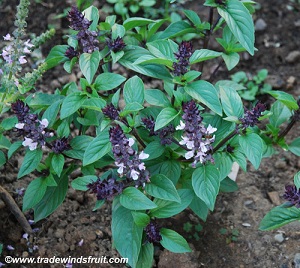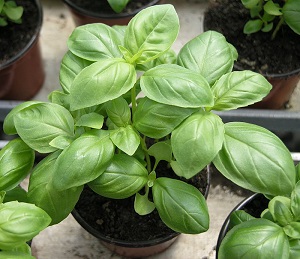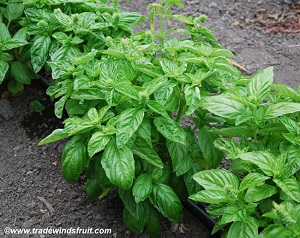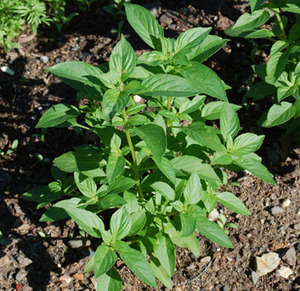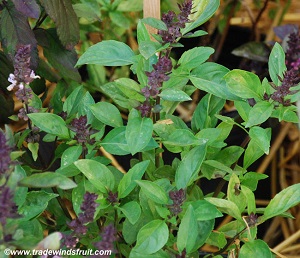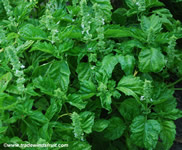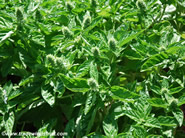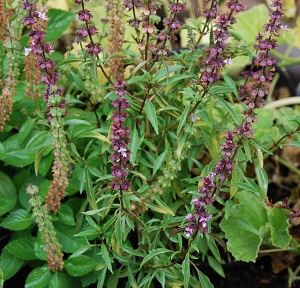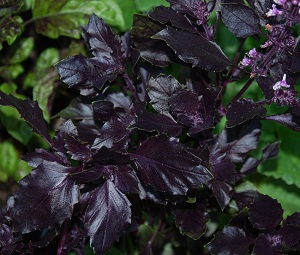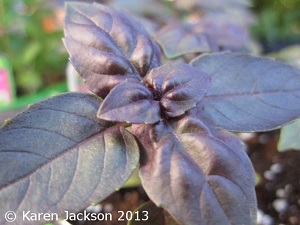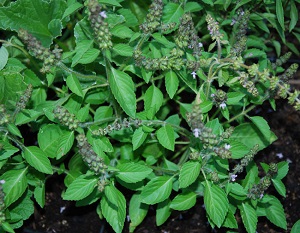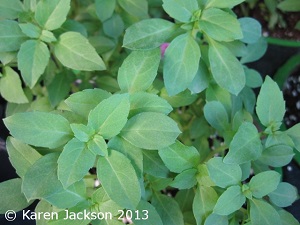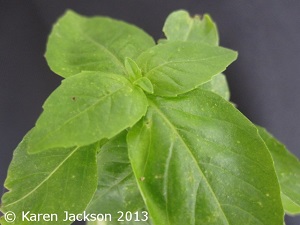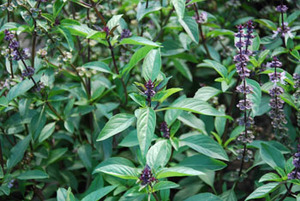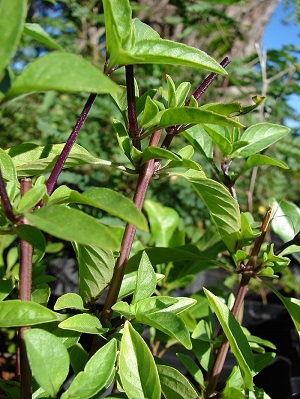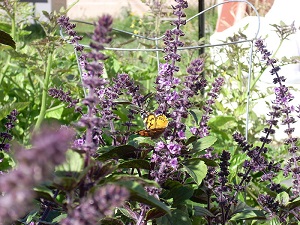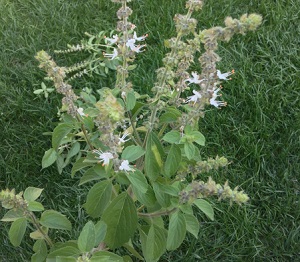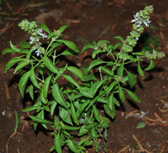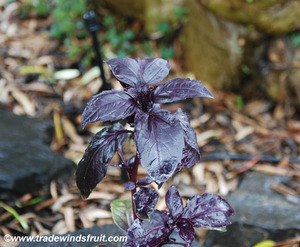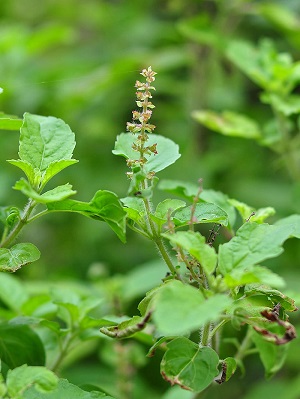Basil Cultivars Ocimum basilicum
Fig. 3. 'Cinnamon'
leaves have a spicy aroma as well as leaving a warm feeling on the
tongue when tasted alone. Good in teas and baked goods. 2
Fig. 5. O. basilicum ‘Genovese.’ With its very large leaves and 30” height, it has the typical familiar aroma as well as taste of the numerous basils called “sweet basil.” An ideal pesto basil. 2 Fig. 7. O. basilicum ‘Lettuce Leaf’ grows to about 24" in height. To most noses, the large leaves have an aroma of both licorice and cinnamon. The excellent flavor is popular for use in salads, pestos and with sliced tomatoes. 2 Fig. 8. O. basilicum ‘Mrs. Burns’ Lemon’ Grown since the 1920s and introduced by Mrs. Burns in 1939, ‘Mrs. Burns’ Lemon’ is a large basil growing to 3’ with a strong lemon aroma. Great in vinaigrettes, beverages and desserts. 2 Fig. 9. 'Licorice'/'Anise' leaves have a spicy aroma that some people detect only as licorice while other people smell more cinnamon or clove fragrance. 2 Fig. 10. ‘Mammoth’ is very similar in growth but has larger leaves than O. basilicum ‘Lettuce Leaf.’ The taste is similar and it is popular for pestos and salads. 2 Fig. 11. O. basilicum ‘Napoletano’ grows to about 20", has the typical aroma of licorice or anise with a spicy overtone of cinnamon and clove. Very popular for sauces and salads. 2 Fig. 12. O. basilicum ‘New Guinea’ has narrow green leaves with dark purple coloring. Grows to about 18'’ with small violet flowers. The strong licorice flavor is both flowery and spicy. A fine basil for container growing. 2 Fig. 14. O. basilicum ‘Purple Ruffles’, a 1987 All America Selection. This 18" basil is a robust, showy basil bred for its ornamental value. It has a nice sweet cinnamon or spicy aroma, but the taste is rather bland. In some areas of the South, this basil tends to lose its deep purple coloring, becoming an unattractive bronzy purple. 2 Fig. 18. This is common basil with wrinkled leaves, white flowers and growing to about 2' (60cm). This is a catchall term for many sweet scented varieties that appear each year. These basils have a balanced fragrance of cinnamon, clove and anise making them very popular. 2 Fig. 19. O. basilicum ‘Siam Queen’ or ‘True Thai.’ A new introduction from Thailand, having a nice spicy aroma. This basil grows only about 18" tall and has purple blossoms forming a cone called a thyrse, rather than a spike of blossoms. Nice for cooking and flower gardens. 2 Other cultivars of O. basilicum are: Bush Green, Genoa Green, Magical Michael, Nufar, Osmin, Piccolo and Well-Sweep Miniature Purple. 2 Ocimum x citriodorum O. x citriodorum 'Lemon.' The dominant aroma of this 24" basil comes through as a lemon balm scent. Flowers develop on this basil sometimes when it is only a 4 or 5" plant. It is difficult to keep this 1940 Thailand basil introduction from blooming, thereby reducing the fragrance of the leaves. Drastic pruning to encourage new leaf production is the solution. Lesbos O. x citriodorum ‘Lesbos.’ ‘Lesbos’ has fine flavor with dark green leaves, with upright growth and seldom blossoms. This plant is also known as 'Aussie Sweetie' and ‘Greek Column’ (Columnar). Great in baked goods and teas. Spicy Globe O. x citriodorum ‘Spicy Globe.’ ‘Spicy Globe’ is a compact plant growing only to about 10" tall. It has a strong spicy aroma. The flavor on the tongue is perfumed but pungent and slightly hot. When growing from seed it is necessary to make selections if this basil is to be used as a border plant. There will be some variance in leaf size and some plants will grow more than 10" tall. They are easily spotted and can be sorted out before planting. Sweet Dani O. x citriodorum ‘Sweet Dani.’ ‘Sweet Dani’ was developed and introduced by Dr. James Simon, formerly at Purdue University. Leaves have a lemon aroma. This 24" tall basil is named for his daughter, Dani. Other Basil Cultivars
Fig. 21. ‘African
Blue.’ is a large bushy plant growing to 4'. Not
usually considered a culinary basil, but useful in flower arrangements
and as a landscape plant. Flavor is sweet, but to some this basil has
strong balsam tones with a hint of turpentine. 2
Fig. 24. O. basilicum x O. forskolei ‘Red Rubin.’ A relatively new basil from Denmark with leaves that are cinnamon-scented. ‘Red Rubin’ grows to about 20" and holds its lovely color in hot summers. A beautiful plant to grow and use. 2 Fig. 25. O. tenuiflorum ‘Thai.’ This plant also has the common name holy basil. This 24" basil in either the purple or green form has a delicate taste of clove. The aroma also resembles clove. 2 Back to Basil Page |
||||||||||||||||||||||||||||||||||||||||||||||||||
| Bibliography 1 "Basil." University of Florida, Gardening Solutions. gardeningsolutions.ifas.ufl.edu/plants/edibles/vegetables/basil.html. Accessed 7 Dec. 2017. 2 Meyers, Michele. "Basil: An Herb Society of America Guide." The Herb Society of America, 2003. www.herbsociety.org/file_download/inline/c2cd2efa-f150-4aac-9c7b-f10a0ccaf889. Accessed 8 Dec. 2018. Photographs Fig. 1,2,4,7,8,9,10,11,12,13,14,19,22,23,24 Basil Cultivars. N.d. Trade Winds Fruit Exotic Seed Catalogue, California. tradewindsfruit.com. Web. 4 Jan 2014. Fig. 3,15,17,18,Jackson, Karen. "Basil Series." 2013. growables.org. JPG File. Fig. 5 Goldlocki. Basilikum großblättriger Genoveser. 17 November 2007. GNU Free Documentation License, Version 1.2, commons.wikimedia.org/wiki/File:BasilikumGenovesergro%C3%9Fbl%C3%A4ttriger.jpg. Accessed 20 Dec. 2017. Fig. 6 Stang, David J. Ocimum basilicum 'Green Ruffles'. 10 July 2006. First published at ZipcodeZoo.com, (CC BY-SA 4.0), commons.wikimedia.org/wiki/File:Ocimum_basilicum_Green_Ruffles_1zz.jpg. Accessed 20 Dec. 2017. Fig. 20 Forest & Kim Starr. Ocimum basilicum var. thyrsiflorum (leaves). Location: Maui, Makawao. 12 August 2008. (CC BY 3.0), commons.wikimedia.org/w/index.php?search=Ocimum+basilicum+var.+thyrsiflorum&title=Special:Search&profile=default&fulltext= 1&searchToken=bn4cp50gk5i4rxjcv6e7zqgtu#/media/File:Starr_080812-9694_Ocimum_basilicum_var._thyrsiflorum.jpg. Accessed 20 Dec. 2017. Fig. 21 Jengod. West Coast Lady butterfly feeding on African blue basil flowers. 24 December 2007. GNU Free Documentation License, Version 1.2, en.wikipedia.org/wiki/African_blue_basil#/media/File:Westcoastlady.JPG. Accessed 20 Dec. 2017. Fig. 25 Joydeep. Ocimum tenuiflorum flower. 24 August 2012. (CC BY 3.0), commons.wikimedia.org/w/index.php?search=Ocimum+tenuiflorum&title=Special:Search&profile=default&fulltext=1&searchToken= 2lwg58cprbtndgw5z8wmhj70n#/media/File:Ocimum_tenuiflorum_24_08_2012.JPG. Accessed 20 Dec. 2017. Published Apr. 2014 KJ. Last update 29 Mar. 2018 LR |
||||||||||||||||||||||||||||||||||||||||||||||||||
